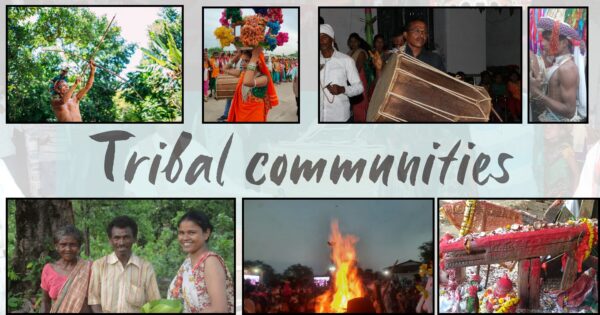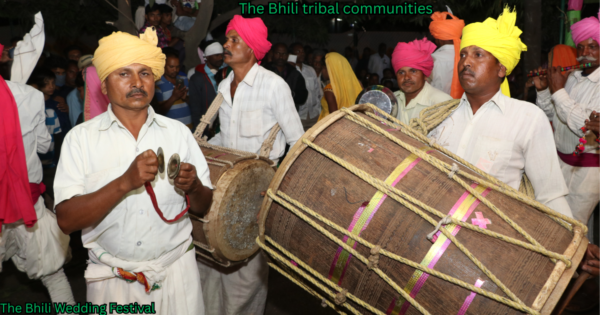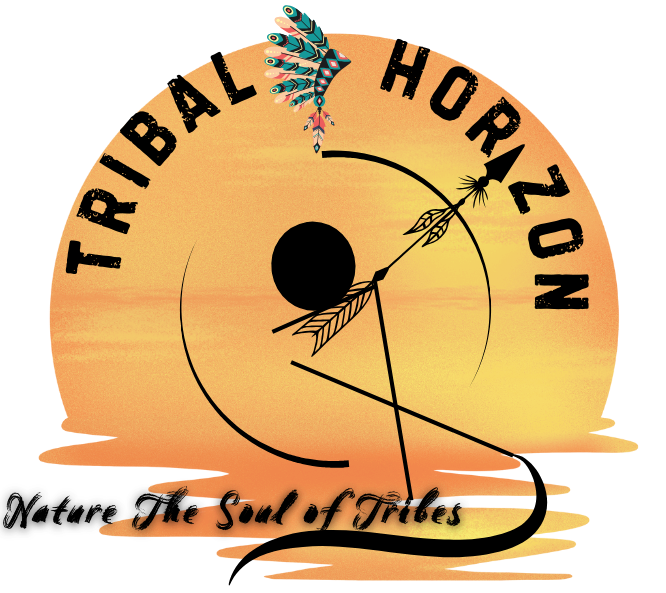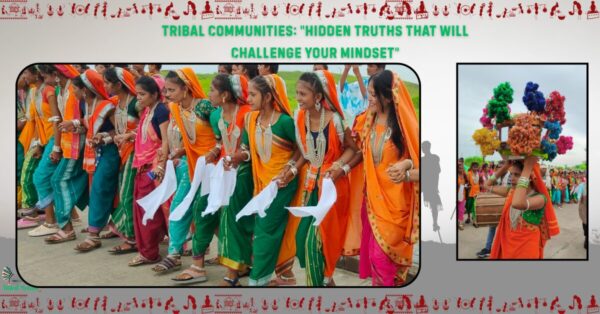Tribal Communities In India

India is a vibrant country that celebrates all its diverse communities and religions. A diverse tribal community (Adivasi samaj) consists of individuals with unique cultures, languages, and traditions. The census showcases the rich variety of castes present in the nation. One community has a special bond with nature, dedicating its lives to living in harmony with the environment. These tribal communities embody simplicity and a deep sense of understanding, making it a place where genuine connections are formed and everyone feels valued.
The tribal communities enjoy living in quiet, spacious areas where they can connect with nature and find peace. They’re known for their calm nature and their willingness to lend a helping hand. While they once depended on agriculture and hunting for their livelihoods, they have embraced new opportunities and are now well-equipped with a variety of options to support themselves.
Tribal Communities In Sociology
The tribal community highlights some of the earliest stages of social development. By studying these fascinating groups, sociologists can discover how their family structures, traditions, customs, ways of living, economies, and governance systems have developed and changed over time. It’s an exciting journey into understanding how people come together and shape their lives!
Social Administration
Tribal communities actively engage with only a limited number of social groups. They embody a strong commitment to a lifestyle rooted in equality, standing in stark contrast to the caste system and the hierarchical structures prevalent in mainstream society.
Understanding Tribal-Nature Relationships
Tribal communities have historically lived in close harmony with nature and maintain strong, sustainable lifestyles. Studying these communities provides sociologists with valuable examples of environmentally centred cultures, which are especially pertinent during today’s natural disasters and crises.
Preservation Of Indigenous Knowledge
The protection of Indigenous knowledge is essential, as tribal communities are invaluable repositories of traditional wisdom. They hold profound insights into forests, medicinal plants, indigenous traditions, customs, agricultural practices, methods of conflict resolution, and oral histories—knowledge that has been meticulously passed down through generations. For social scientists, exploring these local knowledge systems is not just important; it is key to comprehend alternative forms of knowledge and the distinct characteristics that define various societies.
Tribal Communities And The Invisible Divide
tribal communities are undeniably economically and socially disadvantaged, often facing marginalisation in modern nations. Their experiences demonstrate the ways how in which power, policies, and economic systems can exclude certain groups. Therefore, they play a crucial role in the examination of social justice, development, and rights.
Tribal communities’ Population In India
Here is a table showing the population of tribal communities in India based on the 2011 census by the Government of India. Official records indicate that 10% of the tribal community is uncounted due to a lack of written documentation. The latest data highlights the states with the highest tribal populations.
| STATE/UT | Tribal Population | % of State Population | Major Tribes |
| MADHYA PRADESH | 15.3 million | 21.1% | Gond, Bhil, Baiga |
| MAHARASHTRA | 10.5 million | 9.4% | Bhil, Warli, Katkari |
| ODISHA | 9.6 million | 22.8% | Kondh, Santal,Bonda |
| RAJASTHAN | 9.2 million | 13.5% | Bhil, Meena, Garasia |
| GUJARAT | 8.9 million | 14.8% | Bhil, Rathwa, Dangi |
| JHARKHAND | 8.6 million | 26.2% | Santal, Munda, Ho |
| CHHATTISGARH | 7.8 million | 30.6% | Gond, Baiga, Halba |
| AP & TELANGANA | 5.0 million | 5.7% | Koya, Kondareddy, Lambada |
| WEST BENGAL | 5.3 million | 5.8% | Santal, Oraon, Bhumij |
| ASSAM | 3.9 million | 12.4% | Bodo, Mishing, Karbi |
| NAGALAND | 1.7 million | 86.5% | Ao, Sema, Angami |
| MIZORAM | 1.1 million | 94.4% | Mizo, Lai, Chakma |
| TRIPURA | 1.2 million | 31.8% | Tripuri, Reang, Jamatia |
| IN.TOTAL(All STs) | 104 million(10.4 crores) | 8.6% of total population | – |
Tribal Communities And Forest Produce A Deep Connection
What is Forest Produce?
Forest produce encompasses all goods derived from forests and can be categorised into the following broad classifications: 1. Major Forest Produce(MFP): Timber, bamboo, sandalwood 2. Minor Forest Produce(Non-Timber Forest Produce): Honey, tendu leaves, mahua flowers, lac, sal seeds, gum, medicinal plants, wild fruits, wild masrum. Forest produce encompasses all goods derived from forests and can be categorised into the following broad classifications:
Why Forest Produce Matters To Tribal Communities
Around 100 million tribal people in India depend on MFP for survival for their livelihood.The Adivasi’s are deeply revered as maternal and paternal figures. Forests are essential for their livelihoods, providing a variety of natural food sources such as edible roots, fruits, leaves, seeds, tubers, and vegetables. These foods are vital for their traditional diet, especially during periods of food scarcity.
Role Of Forest Produce In Tribal Life
Tribal communities refuse to commercially exploit forest resources, valuing the forest as sacred. While primarily using its resources for domestic needs, they also see it as a vital source of income. They collect and sell naturally occurring items like dried wood, bamboo, seeds, ber, and medicinal plants, supporting their livelihoods while honouring their connection to the forest.
For the tribal community, the forest represents much more than just a place to live; it is the very essence of their lives and a crucial foundation of their existence. For centuries, their lives have been deeply intertwined with the forest and its wildlife, creating a bond that is both rich and profound. Even in today’s world,
many tribal members stand ready to sacrifice everything to safeguard the forests they cherish, highlighting their unwavering commitment and love for their home.
Why Were Tribal Communities In Displacement?
The tribal communities of India have faced sustained economic displacement due to a range of significant factors. It is crucial to understand and address the primary reasons behind the challenges these communities encounter in preserving their livelihoods.
Top 3 Major Tribal Communities Of India And Their Rich Traditions

India boasts a rich tapestry of over 560 tribal communities, many of which have thrived since before the Common Era. Each community possesses a unique identity that clearly distinguishes it from the others. Despite their diversity, there is one undeniable characteristic shared by all these tribal groups: they live in perfect harmony with nature, confidently steering clear of the external world.There is a unique charm and a message in the tribal dances as well. Their rhythmic music creates a deeply positive atmosphere — something you can witness in the video.
Top 3 Major Tribal Communities Of India
1.Bhil – Gujarat,Maharastra,Rajasthan The Bhil tribal community is one of India’s largest and most prominent groups, primarily found in Gujarat, Maharashtra, and Rajasthan. They have a rich cultural heritage, deeply connected to nature and animals, and follow age-old customs. Known for their talent in archery, the Bhils celebrate vibrant festivals and express devotion through traditional folk dances like Ghoomar and art forms such as Pithora painting.They speak the bhili Dialect.
2.Munda – Jharkhand The Munda tribal community is one of India’s oldest and most respected groups, primarily found in Jharkhand, with smaller populations in Odisha, West Bengal, and Chhattisgarh. They have a vibrant cultural heritage that celebrates nature, oral traditions, and strong community bonds. Speaking the Mundari dialect, the Munda people express their unique identity through a rich oral tradition, as they typically don’t have a formal written language.
3.Gond – Andhra Pradesh The Outstanding Ancient Tribal Community of Andhra Pradesh.They speak the Gondi dialect.The Gond tribe is one of India’s oldest and largest tribal communities, mainly found in eastern Andhra Pradesh and parts of central India. Known for their spiritual bond with nature, they preserve a rich culture through mythology, art, music, and oral traditions.
FNQ
What is meant by tribal community?
A tribal community is a close-knit group rooted in ancestral traditions, unique customs, and a deep connection with nature, preserving their heritage through generations.
Who are called tribes?
Tribal communities are deeply rooted in nature, living in harmony with their surroundings. Neither atheist nor strictly religious, they follow vibrant traditions, unique dialects, and ancestral cultures that reflect their rich, nature-inspired identity.
What was the basis of tribal communities?
Ancestors – Importance of strong family and clan Culture and traditions – Heritage of customs, rituals, and festivals Extensive connection with nature – Forests, rivers, and land are considered sacred by all people Self-reliance – Proficiency in hunting, farming and crafts Importance of oral knowledge
Conclusion
Tribal communities embody stories and traditions that powerfully demonstrate diversity and resilience. Respecting their ways of life not only enriches our understanding of the world but also cultivates appreciation for our shared humanity.
By actively supporting their rights, we play a crucial role in keeping their cultures vibrant and alive. Learning about these communities underscores the vital importance of preserving heritage. Take the initiative to educate yourself and honour their way of life with the respect it deserves.
In free to share your feedback.If you have any issues or any kind of questions.you can comment below. Thnak u…..


I consider, that you are not right. I am assured. Let’s discuss. Write to me in PM, we will talk.
——
buy bulgaria virtual phone number online https://virtual-local-numbers.com/countries/64-bulgaria.html for calls, sms, registration (otp)
Why not, of course?